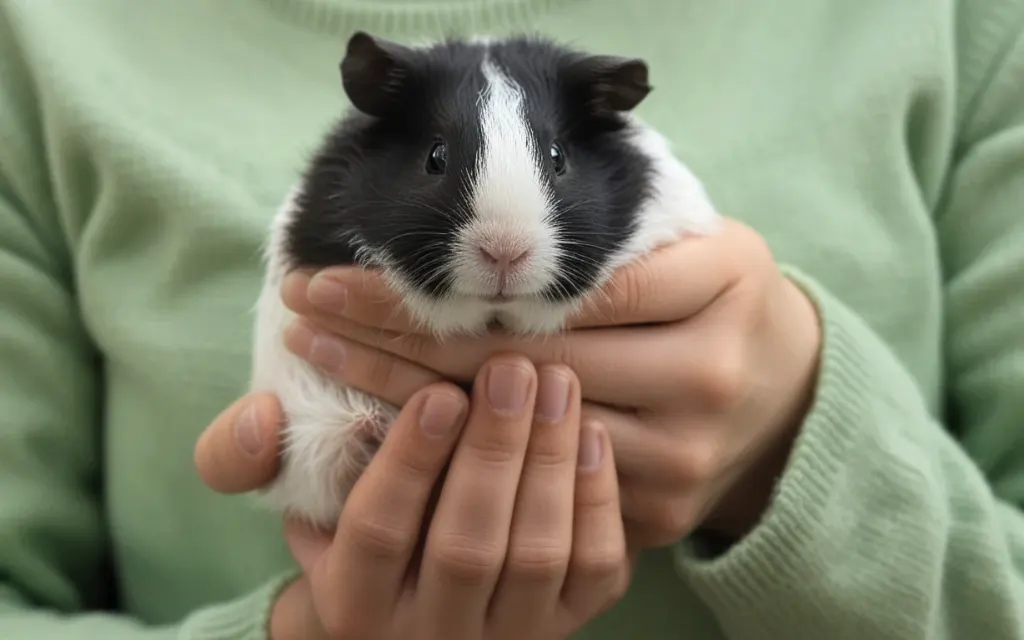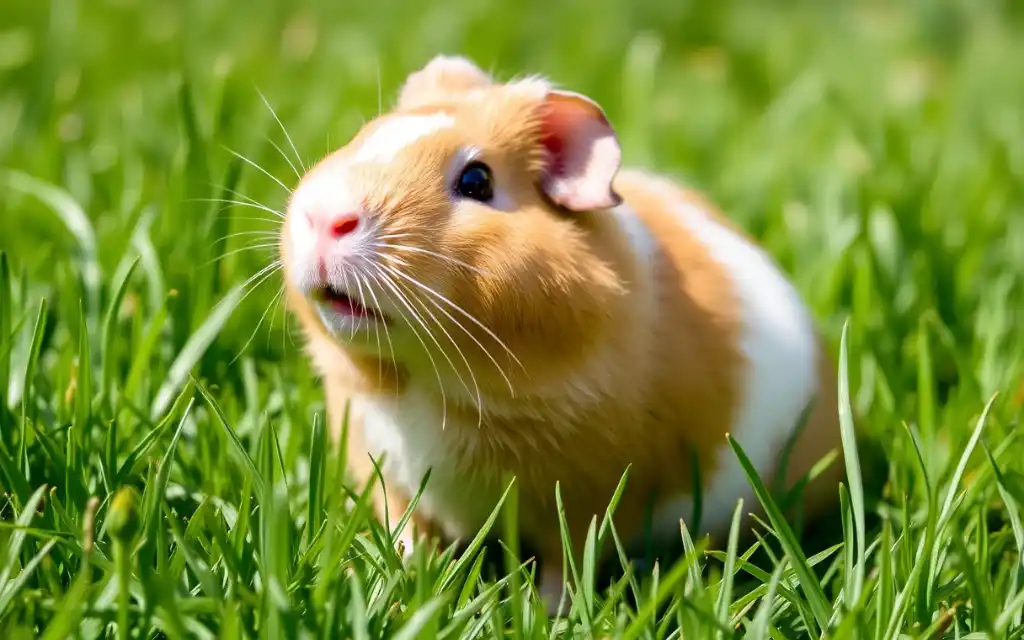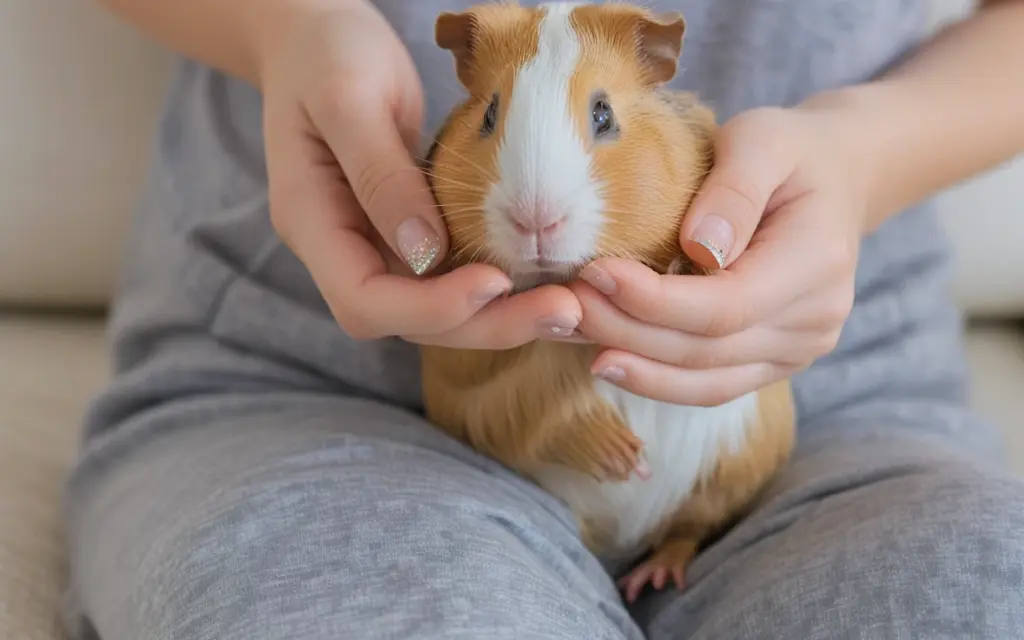Bonding with a guinea pig requires patience, understanding, and empathy, especially if your piggie is skittish or shy. Bringing a guinea pig into your home can be exciting if you can identify and fulfill their unique needs.
In this post, I will help you to know more about their quirky behavior and some vet-approved, actionable strategies to build trust so that you can make a strong bond with these prey animals.
How to create a bond with your guinea pig?

To create a lifelong bond with your furry friend, go through the tips shared below.
Understanding the behavior of your piggie
The most common ways through which guinea pigs communicate are by sounds and body language. However, they are wired to be cautious as these tiny rodents are prey animals. So, the first step to bonding can be learning their language.
Signs of comfort and stress
| Comfort Signs | Stress Signs |
|---|---|
| Making happy hops in the air known as “Popcorning”. | Chattering their teeth, which is a warning sound. |
| Lying down or stretching out with tucked legs. | Rapid breathing or freezing in a place. |
| Making sounds like soft purring when petted. | Hiding for long periods. |
Give respect to their prey animal instinct
Never force the tiny piggies for interaction, but let them approach you first. Loud noises can startle them, so always speak in a quiet and calm voice. Avoid making sudden movements and looming over them.
Make the environment safe and comfortable
Guinea pigs love to stay in places where they feel safe and secure. Creating a stress-free habitat is crucial for strong bonding.
Their living space should be optimized
The cage size for your furry companion should be a minimum of 7.5 square feet to more than 10.5 square feet for one or two piggies. The cage should have needed accessories like fleece tents and wooden huts as hideouts, fleece or paper-based liners for soft bedding, and chew toys like hay-based toys and applewood sticks.
Proper location matters
You should place their cage in areas like a corner of the living room where there is mild foot traffic. This helps them to be near you without being overwhelmed.
Follow a routine
You need to stick to a routine, as consistency builds predictability, which helps in reducing anxiety. Spot clean soiled bedding daily and clean the cage thoroughly every week. Also, feed your piggie at the same time daily.
Food builds trust

Providing food on time and feeding the little rodents with your hand teaches them to associate with you positively.
Hand-feeding
If you are feeding your piggie for the first time, then use long veggies like cilantro or romaine lettuce so that your fingers are at a safe distance. To build familiarity with pair feeding with verbal cues. Once they are habituated and comfortable with hand-feeding, then, you can offer treats from your palm.
Treats that can build trust
| Occasional treats: | Give small portions of blueberries, apples, or carrots 1 to 2 times a week. |
| Safe veggies: | Zucchini, bell peppers, leafy greens, and cucumbers are some veggies that do not have any severe side effects. |
| Foods that need to be avoided: | Raw beans (toxic), iceberg lettuce, and onions. |
Bonding rituals at mealtime
Mealtime can be the best time to create a strong bond with these furballs. Talk to them softly while they eat to normalize your voice. Sit near their cage during meals to make them associate your presence with food.
Handling techniques
Gently handling a guinea pig can be a good idea, as these pets rarely enjoy being held at first.
How should you pick up a guinea pig?
When picking these tiny rodents, approach slowly and let them sniff/see your hand first. Their predator behavior can come into action if you grab them from above. So, avoid doing it. Support their hindquarters and chest with two hands while lifting them up.
Tips for lap time
During lap time, use a blanket or a cozy towel and start with 5-minute sessions daily. Never force them for cuddles and return them to their cage if they squirm. To distract them, you can offer them a treat during lap time.
Consider their boundaries
Respect their stress signals like:
- Teeth chattering or wheening.
- Wants to escape. End the session and try again later if you see these stress signals.
Interactive playtime

Engage your little piggies in structured activities, as playtime is considered the best time to create bonds with them. Performing different activities and playing with them make them see you as a companion and not a threat.
Essentials for floor time
Set up a secure guinea-pig-proof playpen where these fur balls can feel safe. Include essentials like paper bags filled with timothy hay, PVC pipes or cardboard tunnels, and hay-filled boxes for foraging. Let them climb on and around you while you sit inside the playpen to make them comfortable and create a strong bond.
Games and toys
- Use leafy green as a chase game and drag it slowly. This will help your piggie learn to follow you.
- To hunt for their treat, it can be a good idea to use DIY snuff mats with fleece strips tied to a grid.
- Hide veggies inside crumpled paper balls and let them find them out.
Talk to them on a regular basis
As guinea pigs recognize voices, so talking to them daily in a soothing tone can help you create that bond with the tiny rodents. You can use sentences like “Do you want a treat?” or “Good morning! Are you ready for breakfast?” When talking to your furry friend.
Try to learn their language
Decoding their actions and sounds can help you be more connected to your vocal friends.
Most common vocalizations
| Rumbling | Vibrating and deep sound mean irritation or dominance. |
| Purring | High-pitched squeals indicate excitement, usually for food. |
| Wheeking | Vibrating and deep sound mean irritation or dominance. |
Giving responses to their cues
While licking is a sign of affection, nudging your hand means they might want a break. Observe their reaction and be responsive.
Try to be consistent and patient
Every guinea pig is different. Some may create a bond with you in weeks, whereas others may take months. However, going slowly is always best.
Their progress should be tracked
| ☀️Day 1 | They will not hesitate to eat veggies near you. |
| 📆 Week 2 | They will start taking treats from your hand. |
| 📅 Month 1 | They will start climbing your lap on their own. |
Mistakes to be avoided
Never force your piggies to interact if they are not ready. Never try to introduce them to any other loud pets too soon. Daily socialization for at least 10 minutes can be helpful.
Take away
Even though guinea pigs are social and vocal animals, creating bonds with them can take a few weeks to months. Earn their trust through kindness and by making them feel secure/comfortable.
Always remember that bonding with a guinea pig is not a race but a beautiful journey. So, give them the time they need to be completely free with you. Understanding and respecting their quirks can help you form a strong bond with them sooner.
